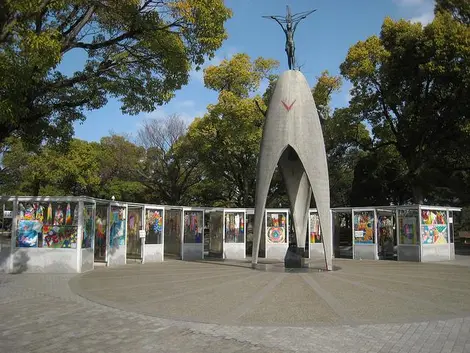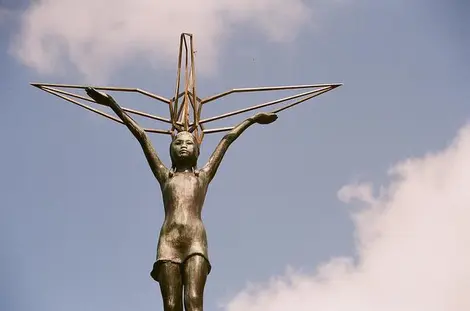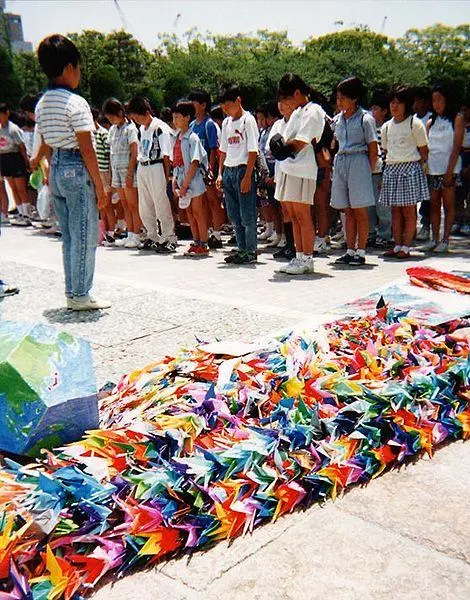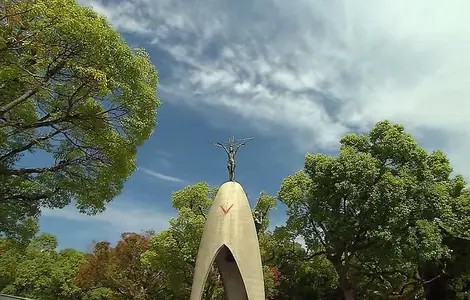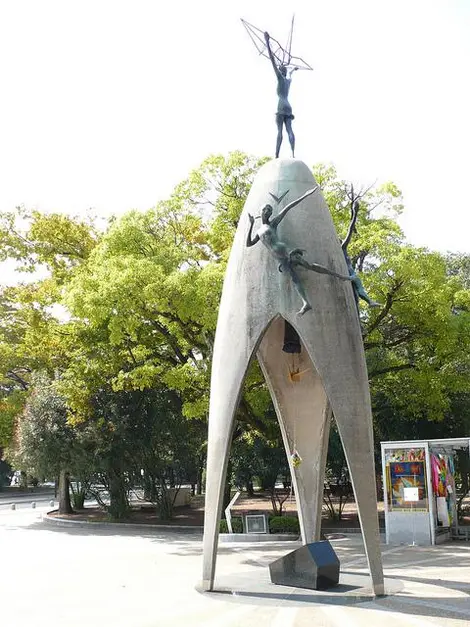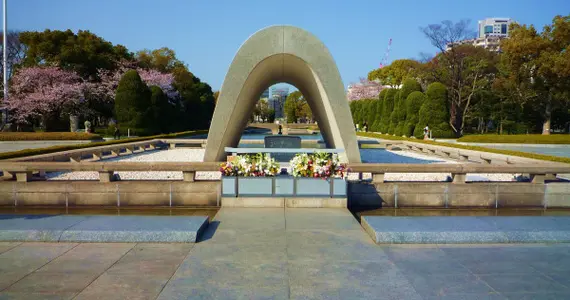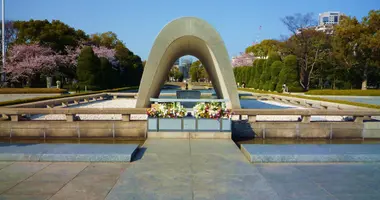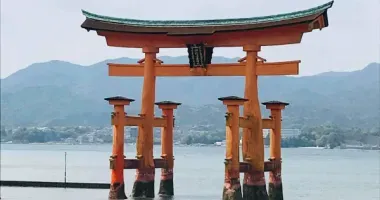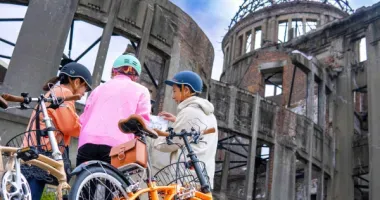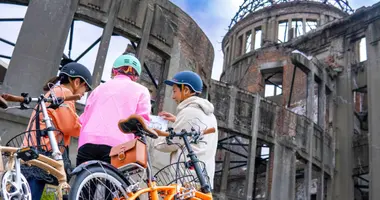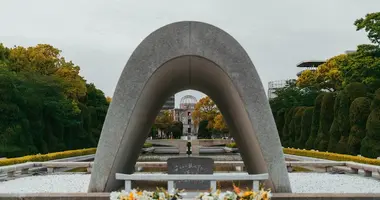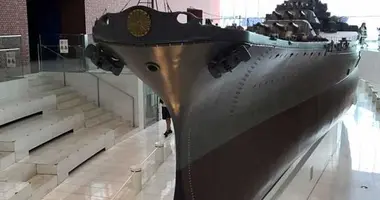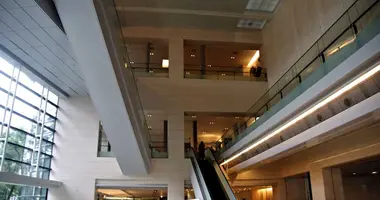The children's peace monument
- Published on : 05/07/2024
- by : A.B.
- Youtube
The Children's Peace Monument, located in the heart of Hiroshima's Peace Memorial Park, is a poignant symbol of peace and hope. Erected in 1958, this monument pays tribute to Sadako Sasaki, a young victim of the atomic bombing, and through her, to all the children affected by this tragedy. Standing 9 metres high, it comprises an oblong structure topped by a bronze statue of Sadako. A stele bears the moving inscription: "This is our cry, this is our prayer, to build a world of peace". This monument has become a place of meditation and reflection on the devastating consequences of war and the crucial importance of peace.
History and significance of the Children's Peace Monument
The history of the Children's Peace Monument is deeply rooted in the tragedy of the atomic bombing of Hiroshima. Inaugurated on May 5, 1958, Children's Day in Japan, the monument was the result of a touching initiative by Sadako Sasaki's classmates. After the death of their friend, these deeply moved youngsters launched a nationwide fund-raising campaign to erect a monument in honor of Sadako and all the child victims of the atomic bomb.
The monument's significance goes far beyond a simple memorial. It embodies the hope of a peaceful future and the burning desire of younger generations to build a world without nuclear war. The paper cranes, which have become an international symbol of peace thanks to Sadako's story, play a central role in the monument's symbolism. Every year, millions of origami cranes are placed around the statue, testifying to the collective will for peace and reconciliation.
Sadako Sasaki: the story behind the monument
Sadako Sasaki has become the human face of the long-term consequences of atomic bombing. Born in 1943, she was just two years old when the "Little Boy" bomb exploded over Hiroshima on August 6, 1945. Although initially unharmed, Sadako developed leukemia ten years later, a disease directly linked to the bomb's radiation.
During her hospitalization, Sadako clung to hope, inspired by a Japanese legend: whoever folds a thousand paper cranes will have their wish granted. So she began folding origami in the shape of a crane, a symbol of longevity and happiness in Japan, in the hope of healing. Sadako succumbed to her illness on October 25, 1955, at the age of 12, after folding over 1,000 cranes.
Sadako's story, her courage and determination in the face of illness, deeply moved her classmates and soon touched the hearts of the whole of Japan. Her short but meaningful life became a powerful symbol of the innocence lost to war, and a call to peace for future generations.
Description and features of the monument
The Children's Peace Monument is an impressive work of art that captures the essence of Sadako's story and the message of peace she embodies. Here are its main features:
- Height: The monument rises to a height of 9 metres, dominating the park landscape.
- Structure: It consists of an oblong granite pedestal.
- Statue: At the top is a bronze statue of Sadako, arms raised to the sky, holding a golden paper crane.
- Bell: Inside the monument is a peace bell, donated by Nobel Prize-winning physicist Hideki Yukawa.
- Inscription: A stele bears the moving inscription: "This is our cry, this is our prayer, to build a world of peace".
Around the monument, special display cases have been set up to house the thousands of paper cranes sent from all over the world. These colorful origami create a striking contrast with the solemnity of the monument, symbolizing hope and resilience in the face of tragedy.
Paper cranes: a symbol of peace and hope
Paper cranes, or "orizuru" in Japanese, have become a universal symbol of peace thanks to the story of Sadako Sasaki. This tradition, rooted in the Japanese legend of the thousand cranes, took on a new dimension after the Hiroshima tragedy. According to this legend, anyone who folds a thousand paper cranes will have their wish granted.
At the Children's Peace Monument, paper cranes play a central role. Every year, around 10 million cranes are placed around the monument by visitors from all over the world. These colorful origami cranes symbolize :
- Hope for a world without nuclear war
- International solidarity for peace
- Remembrance of the innocent victims of war
- Resilience and determination in the face of adversity
Paper cranes have become so emblematic that they are now used in various peace initiatives around the world. For example, on Children's Day in Japan, many schools organize crane-folding workshops to raise awareness of the importance of peace.
The impact and international scope of the monument
The Children's Peace Monument has transcended Japan's borders to become an international symbol of peace and reconciliation. Its impact is felt on several levels:
- Peace education: Sadako's story and the monument are used in school curricula around the world to teach about the consequences of war and the importance of peace.
- International movement: Thousands of people around the world send paper cranes to Hiroshima every year, creating a truly international movement for peace.
- Artistic inspiration: The monument has inspired numerous works of art, books and films, spreading its message of peace through different forms of expression.
- Cultural diplomacy: The monument has become a must-visit site for foreign dignitaries, reinforcing its role in cultural diplomacy.
The monument's impact extends far beyond Japan. For example, a sister statue was erected in Albuquerque, New Mexico, in 1995, creating a symbolic link between the place where the bomb was developed and the place where it was used.
Visit the Children's Peace Monument in Hiroshima
The Children's Peace Monument is a must-see for visitors to Hiroshima. Here's some practical information to help you plan your visit:
- Location: The monument is located in Hiroshima's Peace Park, close to Genbaku Dome and the Peace Memorial Museum.
- Access: From Hiroshima station, take streetcar lines 2 or 6 and get off at Genbaku Domu mae station.
- Times: The park is open 24 hours a day, 7 days a week.
- Admission: Access to the monument is free.
For a more in-depth experience, consider :
- Take a guided tour of the park to better understand its historical context.
- Visit the nearby Peace Memorial Museum for a broader perspective on Hiroshima's history.
- Bring your own paper cranes to place at the memorial.
Remember to respect the solemn atmosphere of the place and take a moment to reflect on the message of peace it conveys. For more ideas for your stay, see our Hiroshima Activities guide.
The monument's role in collective memory and peace education
The Children's Peace Monument plays a crucial role in the preservation of collective memory and in peace education. It serves as a tangible reminder of the devastating consequences of nuclear war and the importance of building a peaceful future. Here's how the monument contributes to these goals:
- Passing on history: The monument and Sadako's story are taught in Japanese schools and increasingly around the world, enabling younger generations to understand the horrors of war.
- Place of commemoration: Every year, on August 6, a commemoration ceremony is held in the park, attracting thousands of people who pay their respects and renew their commitment to peace.
- Promotion of non-violence: The monument inspires discussion of peaceful conflict resolution and the importance of nuclear disarmament.
- Symbol of hope: Despite the tragedy it commemorates, the monument, with its thousands of colorful cranes, symbolizes the hope and resilience of humanity.
Educational initiatives, such as the "Sadako Project" in Honolulu, use the monument's history to teach peace and reconciliation. This project encourages Pearl Harbor visitors to fold paper cranes, creating a symbolic link between two historic World War II sites.
In conclusion, the Children's Peace Monument in Hiroshima is much more than just a memorial. It is a powerful educational tool, a universal symbol of peace and a constant reminder of our collective responsibility to create a world without nuclear war. Visiting this place, one cannot help but be touched by its profound message and inspired to become an agent of change for a more peaceful future.
Visit Peace Park with a specialist Hiroshima guide
Address, timetable & access
Address
Timetable
From Hiroshima station, streetcar lines 2 and 6, Genbaku Domu mae stationAccess
Accessible every day without interruption





